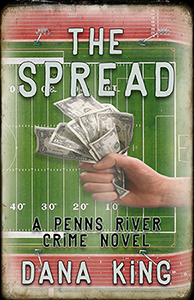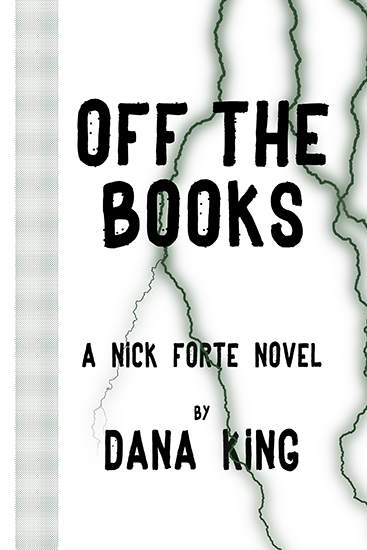Dietrich Kalteis
is the award-winning author of Ride the Lightning (bronze medal winner,
2015 Independent Publisher Book Awards, for best regional fiction), The
Deadbeat Club, Triggerfish,
House
of Blazes (silver medal winner,
2017 Independent Publisher Book Awards, for best historical fiction), and Zero
Avenue. His novel The Deadbeat Club has been translated to
German, and 50 of his short stories have also been published internationally.
He lives with his family on Canada’s West Coast.
Dietrich and I have been friends since we got together at
Bouchercon several years ago. (Exactly which Bouchercon is lost to the
alcohol-shrouded mists of time.) It’s always a treat when he stops by the blog.
His blog, Off the Cuff, is
also a pleasure, especially the multi-person discussions he runs from time to
time, which I can’t think of any other blogs doing.
One
Bite at a Time: Let’s get this out of the way
right at the start so it doesn’t hang over the entire length of the interview:
With a title like Poughkeepsie
Shuffle, people are going to want to know if anyone picks their feet.
You know, they’re in a hotel, they sit on the edge of the bed, take off their
shoes…
Dietrich
Kalteis: Man, I like the way you think, Dana, but no, there is no
feet picking going on in any hotel. But, funny that you mention it because
there is a scene where a couple of the main characters drive down from Toronto
and end up picking up a couple of hookers in a hotel, the two women in the late-night
bar calling themselves Miss Right and Miss Right Now. Of course, things don’t
work out as planned in the hotel room when instead of getting their rocks off,
our boys get ripped off.
OBAAT:
Jeff Nichols is described as “a man strong of conviction but weak of
character.” There’s a hint of cognitive dissonance there. Tell us a little
about him.
 DK:
J Jeff’s likable, but somewhat bullheaded, the kind of guy who refuses to let the lessons of
past mistakes get in the way of a good score. He sees what he wants and goes for it, the kind of
underdog we’d like to see succeed. After getting his release from the infamous Don
Jail, he tries to rekindle a relationship with his ex, Ann Ryan, making his way
in the world by taking a job at a used car lot in a part of town called the
Junction. But, it soon proves to be not enough to keep them afloat. So, when
the lure of easy money comes along, he gets himself mixed up in a gun smuggling
ring, smuggling guns across the border.
DK:
J Jeff’s likable, but somewhat bullheaded, the kind of guy who refuses to let the lessons of
past mistakes get in the way of a good score. He sees what he wants and goes for it, the kind of
underdog we’d like to see succeed. After getting his release from the infamous Don
Jail, he tries to rekindle a relationship with his ex, Ann Ryan, making his way
in the world by taking a job at a used car lot in a part of town called the
Junction. But, it soon proves to be not enough to keep them afloat. So, when
the lure of easy money comes along, he gets himself mixed up in a gun smuggling
ring, smuggling guns across the border.
OBAAT:
Your previous novels have focused on Canada’s west coast, around Vancouver,
mostly, and dealt a lot with drugs. This time we’re in Toronto and it’s guns.
Why the move?
DK:
I grew up in Toronto, and I usually go back once a year or so, and I’m amazed
at how much the city has changed since I lived there. Urban expansion, taller buildings springing up along the 401 and the Gardner,
with roadways around the city expanding to extra lanes, some that didn’t exist
at all when I lived there. It’s still a great city, but, it’s sad in a way to
see some of the places l remember torn away. So, I wanted to bring some of that
back and set the stage for Poughkeepsie Shuffle, weaving in those sights
and sounds and bringing back a grittier, but character-filled Toronto, the way
I remember it back in the mid-eighties, back when nobody knew what a condo was.
And it’s just across the lake from
Niagara and Buffalo, with easy access to the US, making it the perfect setting
for a story revolving around gun smuggling. What sparked the gun angle was an
article I read about a gunrunning ring that operated between upstate New York
and Ontario, eventually being taken down by the OPP, working alongside several
U.S. law enforcement agencies. Another element that worked into the story was
the increasing gang violence that I remember hearing about on the radio and
reading about in the paper.
OBAAT:
We’ve talked about our admiration for Elmore Leonard before and the synopses of
your books could very easily have been Leonard stories. The affinity is in the
writing, yet you never sound as if you’re knocking him off. How are you able to
show the debt without falling into imitation?
DK:
It’s flattering to be compared to somebody you admire, and no doubt, I’ve been
both inspired and influenced by Elmore Leonard’s work, along with other greats
like George V. Higgins, James Crumley, Charles Willeford, Donald E. Westlake,
and Hunter S. Thompson. To me, reading the greats is about inspiration, not
imitation. It’s about transcending those influences, developing my own style
and voice, honing strengths and knowing weaknesses, and finding what works.
OBAAT:
Another thing you share with Leonard is strong female characters. Frankie Del
Rey was the core of Zero Avenue. What’s the deal with Ann Ryan?”
DK:
Ann Ryan’s tough like Frankie del Rey, but she’s more of a home body, and her
fuse is longer. She’s better at taking the crumbs, at least at first, believing
in Jeff to make good on promises to give her a better life. She wants to
believe one of his schemes is going to pay off. Of course, everybody’s fuse is
only so long, and when she tires of Jeff’s schemes, she puts her foot down, and
she’s pretty tough. Frankie on the other hand, never relied on anybody to give
her what she wanted, always ready to kick down some doors and just take what
she was after.
OBAAT:
Time for a hard question. Two things come to mind when I think of controversies
in writing nowadays: diversity and cultural appropriation, which can be like
the proverbial rock and hard place. As a white man, you earn kudos for your
strong female characters. (At least you should.) Do you ever wonder, “I’m not a
woman; how can I write this scene from her point of view and not be accused of
writing what I can’t possibly know?”
DK:
I wasn’t sure I could pull off writing a female lead character before I started
writing Zero Avenue, but since I write about people, and since half of
them are women, I thought I’d give it a shot. I liked that Frankie, being a
woman in the late seventies, seemed more challenged than a male getting into
the music business, that is until you get to know her. Once I got going, it
seemed to work, so I just kept going, writing from her perspective, revealing
my inner Frankie.
For Poughkeepsie Shuffle, I wrote it in first person
from Jeff’s POV. So, Ann is largely seen through his eyes. Writing in first
person did have limitations, mainly I couldn’t shift from one character’s
perspective to another’s. But it allowed for Jeff’s biases to come through, and
that often made it funnier, like when her family comes to visit, all those
thoughts in his head. But, again, once I got rolling, I liked the way writing
in first person was going.
OBAAT:
Let’s talk about point of view a little. How did you decide to write Poughkeepsie Shuffle in first person?
When you write in third, what are the things you consider when decided whose
POV to choose for a scene?
DK:
I hadn’t written a novel in first person before, and I wanted to try it since
it’s primarily Jeff’s story, and it just seemed to be the way to go. Usually, I
like to write in third person, it’s like being the camera in a movie. It’s
flexible and lets me move around and offer more insight, get into different
heads by switching the POV from one character to another.
OBAAT:
Dieter, it’s always fun to chat with you. What’s on the horizon now that Poughkeepsie Shuffle has made its
appearance?
DK:
The next one’s done and with my publisher. It’s called Call Down the
Thunder, and it’s set during the late 1930s. The story centers around a
married couple with some unique ways of surviving the dustbowl days of Kansas.
And I’ve got a short story called “Bottom Dollar” included in the Vancouver
Noir anthology by Akashic Books, coming out this November. Right now I’m
working on a new novel about a guy who’s on the run after stealing a gangster’s
money and making off with his woman.




